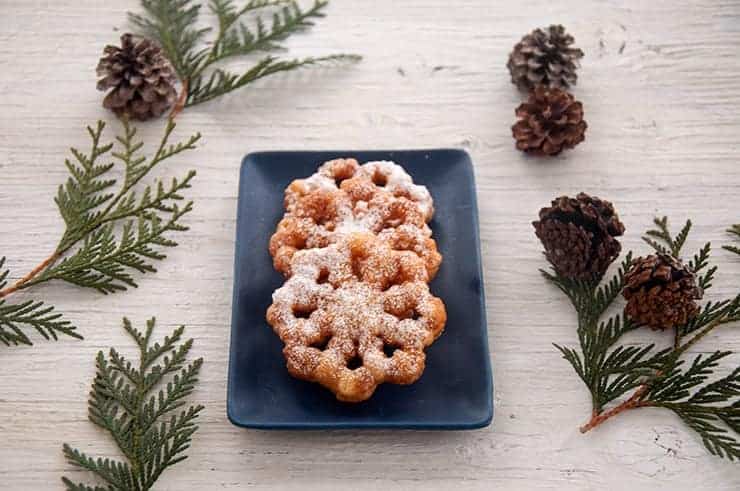This post may contain affiliate links. As an Amazon Associate I earn from qualifying purchases. Please read our disclosure policy.
Rosette Cookies are a Christmas time favorite for many Scandanavian families and can be enjoyed by your family too! These sweet and crispy treats take a little patience to make, but they are well worth it. Making these traditional cookies are a great holiday activity and can help bring your family together in the kitchen or at your Christmas feast.

If I were to try and describe Rosette Cookies to a person who has never seen them before, I would say they are a really thin and delicious cookie, but just a little different than a normal cookie. They are somewhere between a cookie, a donut, and a tasty churro. They take the shape of a flower, snowflake, or other Nordic icons.
While a churro almost always has a cinnamon and sugar coating, a rosette may often be coated with powdered sugar, sugar, or maybe dipped in a glaze. Today, I will be using powdered sugar for this treat and walk you through my Rosette Cookie recipe.
While I have been eating Rosettes for as long as I can remember, this is our first year making them. We decided last year that this was going to start being one of ‘our’ things that my wife and I do together over the holidays. I recently posted a lefse recipe and rosette cookies are going to join that circle of special traditional recipes.
The basics of cooking a Rosette Cookie are that you take an iron, or a literal piece of metal with a shape on it, and heat it up in cooking oil. Once heated, you dip it in cold batter long enough for the batter to stick to the rosette iron.
Then, you place it back in the fry oil and cook until crispy and golden brown. Once cooled a little, you top them with powdered sugar.
The Zen of Rosette Making
There is a sort of peacefulness of making this dish. Because we are only cooking one at a time and it requires some patience, it becomes a bit of a process-oriented task that demands us to pay attention to what we are doing and ‘be’ in the moment.
If there are more than one of you making these cookies, you likely will each have your designated tasks. When we make them in our house, one of us does the actual frying and then once it is on the cooling plate, the other person is in charge of making sure the topping is put on and they are stored properly.
If this is your first time making Rosette Cookies, I want you to know that it is ok to make mistakes. When a mistake happens, just know that there is a next rosette. Get the batter off your iron and start fresh. The next one will be better. This recipe literally makes 5 dozen cookies, so you have the next one to work on. It’s ok. There is no reason to get mad about cookies.
This is my first year making Rosette cookies, but I have made a whole bunch of them. I am going to try and share as many of the problems I encountered or could see as potential problems.
You Need a Rosette Iron to Make these
They are not that expensive and I found some online that look like they would be great. Here is the rosette iron handle [Affiliate link] and here is the actual iron [Affiliate link]. There were some that came together in kits, but I didn’t feel too good about them. These Honey-Can-Do products looks legit and the real deal to me.
If you have a Scandanavian store around you, you might be able to find them or even some of the Big Box stores like Target carry Rosette Irons.
We found our irons in the thrift store. There are enough Norwegians and Swedish people around here that they become fairly easy to find after the Holiday season if you keep an eye out for them.
Rosette Batter
This batter is super simple. It is a matter of mixing the ingredients together and making sure it is smooth. There is, however, a caveat to this that I want to warn you about. In the directions, I indicate to cool the batter for two hours before cooking.
Do not skip this step. I found that it helps bring the temperature difference between the hot iron and the batter to a point where it helps ensure that the end product is crispier.
You can get away without cooling the batter for two hours, but what I found is that the batter started warming up. I think this attributed to it sliding off of the iron, but only after making several successful Rosettes.
One of the original problems I had was that some of my Rosettes turned out soft like donuts rather than the crispiness I expect. I also noticed that it happened as my cooking went on. That is, my Rosette cookies that I cooked at the beginning were better than the ones I cooked later on. While this was probably partially due to oil temperature, a definite contributing factor was that my batter was not cool. I would suggest cooling that batter.
In fact, I keep two sets of batter. The large bowl of batter that I cooled in the refrigerator for 2 hours and then I pour some of that into a smaller container that my Rosette iron just fits into.
When I am actively cooking the rosettes, I keep the big container in the fridge and then fill up the small one when I have to. This way, I always have cold batter and there is less opportunity for waste. If the bigger container has a wider base, you will get less final products out of it.
Oil Temperature for Cooking Rosette Cookies
This is a super important element of cooking a good, crispy rosette. I try to keep my oil between 370 and 375 degrees Farenheight. Since I am heating my oil on the stovetop (that does not have great temperature control), I keep my point thermometer close by [Affiliate Link] and I temp it between each rosette.
Then, I adjust my burner accordingly, with the hopes of keeping it in that 370°-375° Fahrenheit range. If you get below 360° or above 400°, you will start to have real problems. Anywhere, however, in between that range you should still be able to make Rosette cookies, but keep a closer eye on timing. On the lower end of the temp, you might need a bit more time and less time on the higher end.
While many factors can impact the cooking time needed (preheating iron, batter temp, rosette iron size, oil temp), I found that the sweet spot was 50 seconds when between 370°-375°. Use your judgment to make a cookie that is a nice golden brown and then remove at that point.
Oil Safety
Remember that you are dealing with hot oil and to take hot oil precautions. Check out this USDA page on Frying safety and take it seriously. No reason for someone to get hurt because of cookies!
Dipping Your Iron Too Deep
Did you dip your Rosette iron so deep that the batter covered the top of the iron? It is ok, but it will just take a bit more effort to remove. I use a knife to scrape the top and make it easy to loosen from the iron.
Removing the Cookie From the Iron
Sometimes the rosette cookie just falls off the iron at just the right time. Sometimes, they can stick to the iron. Others, it loosens right in the fry oil. I keep a fry skimmer nearby to remove the rosettes if they fall of the iron into the oil.
If the batter is stuck to the iron and it is still doughy… the rosette probably isn’t done cooking. Dip it back into the oil and let it cook a bit longer. If the batter looks a nice crispy golden brown, but still is sticking to the iron, try a fork. I keep a fork near the cooking area.
Since the cooked cookie is formed in the shape of the iron, it fits over it like a crust. Using a fork, I gently loosen the sides and maybe have to use it on the inner edges of the rosette iron as well. It is a delicate shimmy to get these ones off.
Once you have the cookies off of the iron, allow to cool on a paper towel covered plate.
Adding the Powdered Sugar Topping
After a few minutes of cooling, you can sift some powdered sugar over the top of these cookies to give a beautiful Christmas-time look and add a bit of a sweet flavor. Add as much as you like, but I accounted for about a ½ teaspoon of powdered sugar for the rosette’s of the size I make.
If you are working with a second person, that is a great job for a kid or significant other to do.
Different Toppings
I use powdered sugar in this recipe, but there are other options. Some people just top with granulated sugar. I often see rosettes covered in a sugar and cinnamon combination. I have also seen people make a simple glaze and dip the underside into it. The point being, here is a place where you can experiment and try different things. This recipe makes 50 rosettes and you can try different things.
The Timing of Cooking Rosettes
You are going to have many opportunities to improve your process, as there are 50 cookies in this recipe and we are cooking them one at a time. For me, once I have all of my tools in place and the oil heated up, I have the following process:
- Put rosette iron (no batter) in oil for 1 minute 30 seconds and I start a stopwatch at this time. During this time where both hands are free, I take care of anything that needs to be filled, changed, fixed, or otherwise addressed. Sifting sugar on batches of rosette cookies.
- Dip hot iron into the batter for a few seconds.
- Place iron back in oil and cook for 40-50 seconds or until golden brown.
- Lift iron to get intial drips of oil off and at the same time temp the oil. Adjust temperature as needed
- Get cookie onto paper towel-lined plate.
- Go to step one.
Note on Calorie Count and Oil
I started off with 4 cups of oil and ended up with three after all 50 cookies were completed. While I don’t know exactly what was absorbed by the cookie and what evaporated, I presume all of the oil goes into the cookie. Also, your iron size is going to impact the calorie count of your cookies.
50 Is Too Many Cookies! What Can I Do?
Cut the recipe in half, silly. There really isn’t much substance to these cookies, however, and they can go really quick because they taste so dang good.
Rosette Cookie Cooking Process

- Preheating oil so that when I put the iron in the batter, it will do a nice job of frying it and creating a layer of the batter appropriate for the cookie.
- Dipping. At this point, I hear a bit of sizzle. This is good!
- Move it to the oil and cook for 40-50 seconds or until a nice golden brown.
- Remove Rosette Cookie from oil. For me, this is the point when I temperature my fryer oil to make sure I am in that 370°-375° Fahrenheit range and adjust if necessary
Rosette Cookie Cooking Tips
- Have patience! These cookies take a bit of time and while the batter is super simple, it does require a bit of practice to get the cookies right.
- Use two containers for batter. The main container that is kept in the fridge to keep cool and then a small one that is just big enough for your iron to comfortably fit in. When my iron is heating up, I will fill this if needed.
- If the batter is sticking to the iron and the dough is not golden brown, cook longer.
- If the batter is cooked to a nice golden brown and it is still not loosening from the iron, use a fork to ‘shimmy’ the cookie off.
- Use a sifter to coat with powdered sugar, but allow your cookies to cool, but not completely, before adding the sugar.

Products I Used in this Recipe
Did you Make These Rosette Cookies?
Awesome! I hope it went great and they taste really good. It would be so nice if you could leave a comment below to tell me how it went for you. Also, if you could share this on Pinterest or Facebook, it would really help me out. Of course, if you are interested in getting recipes from me in your email, sign up to get them in the sidebar.
Print
Scandinavian Rosette Cookies – Rosettbakkels
- Prep Time: 2 hours 15 minutes
- Cook Time: 2 hours 30 minutes
- Total Time: 4 hours 45 minutes
- Yield: 50 Cookies 1x
- Category: Dessert
- Method: Fry
- Cuisine: Scandanavian
Description
A tasty traditional Scandinavian cookie that is sweet, crispy, and special. Whether you are making them for you, your family, or a big event, these Rosette Cookies are visually stunning and show the care you put into your cooking. A Christmas favorite in our house and I am happy to share it with you!
Ingredients
- 1 teaspoon vanilla
- 1 teaspoon salt
- 1 tablespoon sugar
- 2 eggs
- 1 cup whole milk
- 1 cup all-purpose flour
- Vegetable Oil, for frying (I used 4 cups)
Instructions
- Add all ingredients except oil and flour to mixing bowl and beat.
- Slowly add flour and continue beating. Your end better should be smooth.
- Put in refrigerator for 2 hours
- After that time has passed, heat oil to 370° – 375° Fahrenheit in appropriate pot (See Notes on Oil Safety).
- Put rosette iron (no batter) in oil for 1 minute 30 seconds and I start a stopwatch at this time. During this time where both hands are free, I take care of anything that needs to be filled or taken care of, such as sifting sugar on batches of rosette cookies (see notes).
- Dip hot iron into the batter for a few seconds, making sure not to fully dip the iron. That is, the batter should not reach over the top of the iron design.
- Place iron back in oil and cook for 40-50 seconds or until golden brown.
- Lift iron to get intial drips of oil off and at the same time temp the oil. Adjust temperature as needed
- Get cookie onto paper towel-lined plate. (See notes on cookies that are tough to get off of Rosette Iron)
- Repeat steps 5-9 until all are cooked
- If you haven’t sifted powdered sugar on them yet, do so now.
Notes
- Have patience! These cookies take a bit of time and while the batter is super simple, it does require a bit of practice to get the cookies right.
- You are using hot oil. BE SAFE!
- Use two containers for batter. The main container that is kept in the fridge to keep cool and then a small one that is just big enough for your iron to comfortably fit in. When my iron is heating up, I will fill this if needed.
- If the batter is sticking to the iron and the dough is not golden brown, cook longer.
- If the batter is cooked to a nice golden brown and it is still not loosening from the iron, use a fork to ‘shimmy’ the cookie off.
- Use a sifter to coat with powdered sugar, but allow your cookies to cool, but not completely, before adding the sugar. You can sift powdered sugar onto the rosettes when done or during the 1 minute and 30 seconds when the iron is heating. Just do not powder too soon, otherwise it may gunk up a little on the cookie. They are still great, but the unsettled oil can mess with delicate powdered sugar.
Nutrition
- Serving Size: 1 cookie
- Calories: 60
- Sugar: 2 g
- Sodium: 52 mg
- Fat: 5 g
- Saturated Fat: 1 g
- Unsaturated Fat: 4 g
- Trans Fat: 0 g
- Carbohydrates: 4 g
- Fiber: 0
- Protein: 1 g
- Cholesterol: 8 mg










I use an electric frying pan. I just set the temp to 375 degrees and then don’t need to worry about the Oil getting too hot etc…
I’m so excited to make these rosettes. I used to make them when my boys were young. They are 41 and 44. I’m going to surprise them with a big batch. Thank you for the recipe! 😋
Enjoy!
Used to make these cookies many years ago. I am looking forward to make them again as I just received my iron and patterns.
Brilliantly explained and helpful tips. Thank you for sharing your recipe and tips. My mom, now 88 made it for us as kids. I was so delighted when I managed to get hold of one. Thank you, Chef!
So glad you liked it! I always love when I can help recreate a treat or recipe from someone’s childhood.
When cookies are cool, I melt block chocolate and dip rosettes in it (forms a chocolate shell).My families favorite is white chocolate.
These cookies are a must do for Christmas each year. I just finished my batch of cookies and found your article while taking a break waiting for the oil to cool down so I can clean up. Happy to see my grandmother’s recipe matched yours exactly. I have the same iron, which was handed down from my great grandmother to my grandmother to me. We eat ours drizzled in honey and sprinkled with crushed walnuts. I have never tried cooling the batter and I’m happy to have that tip for next time. Other than that my method is the same as yours. My grandmother taught me to make these and she’s been gone almost 20 years. I’m happy to carry on this tradition for my family.
That is so great! Happy Christmas, Michele!
I’ve been making rosettes since I was in high school and love my recipe but my next batch I’m going to try your recipe. My recipe doesn’t call for vanilla and less sugar and salt. The only thing I do different (and won’t change) is that I quit using shortening for the oil and changed to lard. I used to get an oily taste but with the lard I don’t.
Hard to go wrong with lard. 😉
excellent recipe and instructions!
they turned out just the way I remember them.
Awesome! Thanks for giving it a try, Lyn!
Please clarify the yield from your rosette recipe calling for 3 cups of flour.
The information given says:
Yield: 150 Cookies 3x
What does the 3x refer to?
Would I get 50 cookies if I divide all ingredients by 3?
I remember these cookies from a Girl Scouts activity about 68 years ago.
Quite the festively delicious memory. Thank you.
It looks like you must have clicked the ‘3x’ in the scale of the recipe. The original recipe makes approximately 50 cookies. If you scale it to 3x, it would make 150.